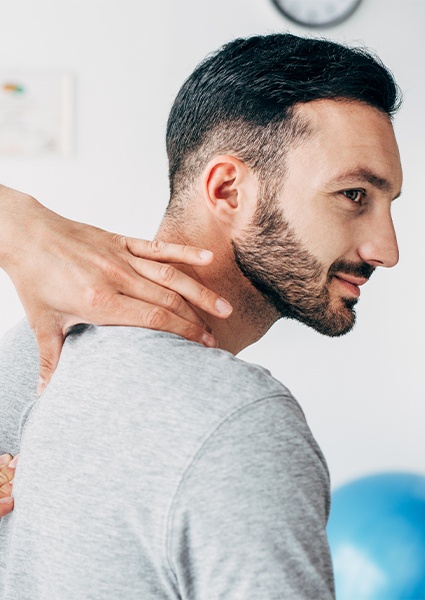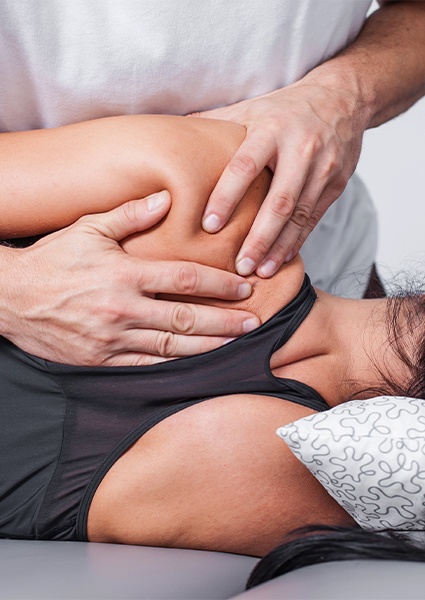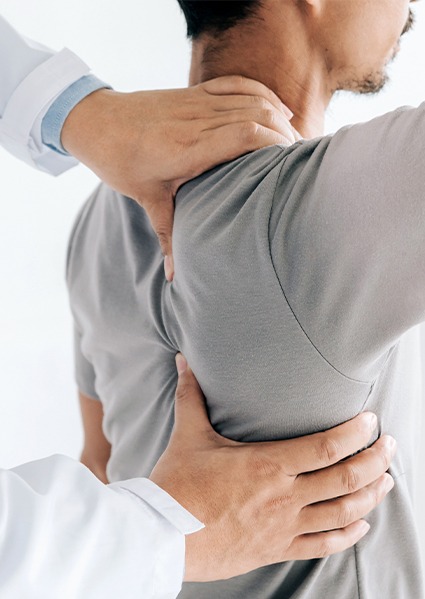Osteopathic Manipulation – Fort Lauderdale, FL
Hands-On Treatment
For Lasting Comfort
Balance is extremely important to the body. Osteopathic manipulation is a hands-on treatment that is designed to restore this balance when it has been thrown off by an injury. It has been shown to provide lasting pain relief and speed up recovery from a variety of musculoskeletal issues, allowing patients to get back to their normal lives without having to rely on medication or surgery. This gentle, non-invasive treatment is provided by experts here at the Institute for Non-Surgical Orthopedics, and you can learn more and schedule an appointment by contacting us today.
Why Choose the Institute for Non-Surgical Orthopedics
for Osteopathic Manipulation?
- Able to Help with Pain in the Head, Neck, Back, Extremities & More
- Fully Customized Approach for Each Patient
- Designed To Work with Your Body To Deliver Fast Results
Muscle Energy / Isometrics

You have probably heard the term “isometric” associated with exercises that involve positioning the body in a way where certain muscles are engaged, but the person isn’t actively moving. A popular example of this is planking, and it is an integral part of many yoga poses. In our practice, we use it by having a patient extend or contract a muscle, and gently with their hands, the doctor applies resistance in the opposite way. The muscle is engaged, but not moving. This can relieve pain and increase the range of motion by improving blood flow to the area and loosening up tense or “stuck” tendons that may be restricting movement.
Cranial Osteopathy

Cranial Osteopathy is the name given to a subtle and refined approach to osteopathic treatment that follows all the principles of osteopathy, but that includes the anatomy and physiology of the head. Cranial treating osteopathic physicians use a highly trained sense of touch to feel subtle changes of tension and tissue quality in the living anatomy of the whole body, and to diagnose areas of strain or dysfunction. Diagnosis and treatment are linked as the physician works to activate the innate ability of the body to heal itself, and by offering gentle and specific support where it is needed to bring the tissues into a state of balance and release, to restore it to health.
Learn More About Cranial Osteopathy
Myofascial Release

The fascia is a thin band of tissue found beneath the skin throughout your body that provides support for many structures, including the bones and muscles. Like muscles, the fascia itself can become strained or injured, leading to the development of “trigger points,” or small areas of intense pain that cause discomfort to be felt in a wider area. Myofascial release is used to identify and stop this pain, which can not only help a patient feel better, but it may also improve their mobility, as a dysfunctional area of fascia may hamper muscle movement.
Learn More About Myofascial Release
Counterstrain / Positional Release

Many of the muscles throughout the body work in pairs—when one engages, the other relaxes, and vice versa. A good example of this is your arm. When you curl your arm, your bicep tenses while the triceps relax. Extending the arm does the opposite. So, for tense or injured muscles, it may be possible to place the body into a position that naturally causes them to relax. These positions are likely ones that you do not find yourself in during daily life. Holding a therapeutic position as instructed by a doctor for a few minutes in the office has been shown to result in immediate pain relief, and when done regularly at home, positional release has the potential to provide a long-term solution to stubborn pain.
Facilitated Positional Release

With Facilitated Positional Release (FPR), the doctor places the body in a position where a strained muscle is able to naturally relax, and then they carefully move that part of the body to release even more tension. This is normally recommended for smaller muscles that may be difficult to reach with traditional OMT, plus it can help reorient misaligned joints that might be contributing to the discomfort as well.
High Velocity, Low Amplitude

The spine is a complicated part of the body, consisting of a stack of vertebrae and discs that protect nerves, and they are all supported by muscles. If any one of these elements becomes injured or misaligned, it can lead to neck or back pain. With high velocity, low amplitude adjustments (HLVA), the doctor uses their hands to quickly manipulate the spine to correct any misalignments, leading to a reduction in pain and stiffness. The motion itself is very fast, but it does not place any pressure on the spine. A patient may hear an audible pop during a session, and the benefits can often be felt immediately.
Osteopathic Manipulation Frequently Asked Questions

The terms “osteopathic manipulation” and “osteopathic manipulative treatment” (OMT) are foreign to a lot of people, so if you still have questions about it even after reading over this page, you’re far from alone! We’ve gone ahead and responded to some of the most common questions we receive about it below, but if there is anything else you would like to ask that we haven’t covered here, don’t hesitate to reach out to our team!
How is OMT different from chiropractic care, physical therapy, and massage?
OMT, chiropractic care, physical therapy, and massage may all look similar on the surface, but the techniques used, and the goal of those techniques, is very different between the disciplines. The biggest differentiator, however, is the type of person who is allowed to provide OMT. Only a fully trained and licensed D.O. can offer OMT and use it as part of an overall treatment plan to address a wide variety of conditions. While the other methods listed here can certainly help with recovery and reduce certain symptoms, only OMT can act as a medical treatment and is performed by a doctor (chiropractors are not doctors in the traditional sense because they don’t go to medical school).
Am I a good candidate for OMT?
People dealing with a wide variety of musculoskeletal issues, like muscle tears, strains, and sprains, can benefit from OMT, as can those who have joint problems, digestive issues, and more. If you are hoping to recover from an injury without relying on strong medication or undergoing surgery, OMT is a viable option as well. To determine whether or not it would be a worthwhile treatment for you, it’s essential that you be evaluated by an osteopathic doctor. They can help determine if OMT, either by itself or combined with other techniques, would best fit your situation.
Does OMT hurt?
It’s important to note that OMT is not the same as a relaxing Swedish Massage, nor is it an intense deep tissue treatment either. Depending on the patient, OMT is designed to challenge and relax certain muscles and tissues, and while this might cause mild discomfort in some cases, the ultimate result will be a balanced, more functional body. At moments, it can feel fantastic because it is helping a tensed muscle relax, but it also may be used to release a stuck muscle, which isn’t exactly pleasant in the moment (but is great afterward).
Will my insurance cover OMT?
Our practice is able to accept many different medical insurance plans, but it’s important to read the fine print before trying to use your benefits. Many medical insurance plans offer coverage for OMT, but it may only be applicable if the treatment is being used for certain conditions. We recommend talking to your provider, but our team is also happy to go over your plan with you so that you fully understand your out-of-pocket costs before you receive treatment. We can also discuss how we can make things more affordable during your initial consultation.









